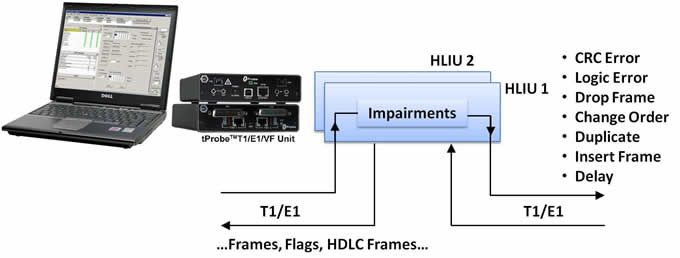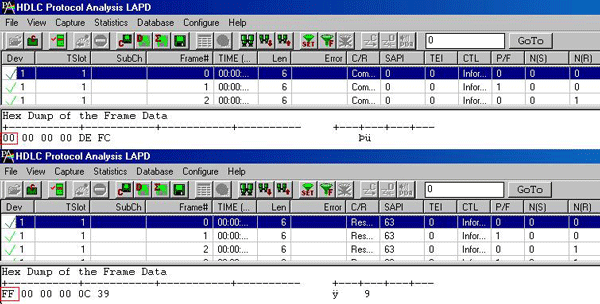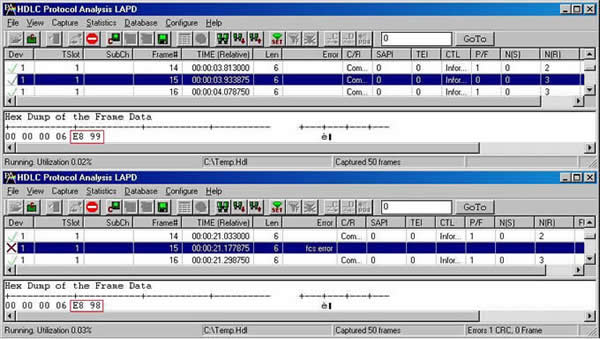Newsletter: GL Announces Enhancements to
HDLC Testing Tools
Welcome to our February 2013 issue of GL Communications' Newsletter providing information on our HDLC Testing Tools and enhancements to HDLC Link Impairment Utility (HLIU). HDLC is a Layer 2 "backbone" protocol for reliable transport of data, voice, and video. It is used to encapsulate almost all other higher layer protocols such as ISDN, PPP, and Frame Relay. It is also used to encapsulate Ethernet frames over WAN links.

Overview
HDLC Impairment Utility impairs HDLC frames on T1 E1 lines, whether they occur on single timeslots at 64/56 kbps rate or as hyperchannels wherein contiguous timeslots are used to create N x (64/56 kbps) channels, with N possibly equal to the max timeslots of 31/30/24. The application can use any of GL's T1 E1 platforms including T1 E1 Universal Cards, tProbes™, USB T1 E1 Analyzers, and Octal T1 E1 Cards.
The application is useful in simulating real network conditions and the impact thereof on protocols such as ISDN, SS7, and other HDLC based protocols. It is also useful in verifying proper operation of HDLC hardware/software implementations.
Impairments that can be introduced are: Logic Errors, CRC Errors, Drop a Frame, Change Order of Frames, Duplicate a Frame, Insert a Frame, and Delay a Frame. These impairments can be introduced manually or automatically with a specified random rate, e.g. 1x10E-04, or one in 10,000.
GUI and Operational Features
The GUI screen below shows the main features of the application. Note that automatic error rate can be from 1x10E-6 to 1.0. The input and output ports can be the same or different (Card1 (Port1) or Card2 (Port2)).
HLIU can be used in conjunction with GL's HDLC Playback File, HDLC Tx Test, HDLC Rx Test, and HDLC Protocol Analysis applications.
Examples of Impairment Types
- Logic Error: The first byte of the HDLC frame is complemented, i.e. the screenshot below depicts the first byte of the frame # 1 changed from"00" to "FF"

- CRC Error: Single shot CRC Error into an HDLC frame alters (either increments or decrements) the last two bytes (CRC). The screenshot below shows the CRC error inserted on frame # 15 and the CRC value is decremented from "E899" to "E898".

- Drop Frame: Drops a HDLC frame from the incoming stream and sends continuous flags in the place of the dropped HDLC frame. The screenshot link provided depicts the frame # 1 contents changed from "01" to "02" due to a previously dropped frame. The user can click to view the Drop Frame screenshot.
- Change Order: Two consecutive HDLC frames are reversed in sequence at the output. The screenshot link provided shows how frame # 0 content is changed from "00" to "01" and frame # 1 content is changed from "01" to "00". The user can click to view the Change Order screenshot.
- Duplicate: Duplicates a frame and transmits the duplicate frame right after the original frame. The screenshot link depicts frame # 0 duplicated as frame # 1. The user can click to view the Duplicate screenshot.
- Insert a Frame: Inserts a predefined frame at the output. The screenshot link depicts that at the end of 100 frames of transmission, a predefined frame is being inserted and the total frame count is incremented by "1". The user can click to view the Insert a Frame screenshot.
- Delay Frame: The input frame is delayed before output by a specified amount of time in milliseconds. The screenshot link depicts the delay of 5000 ms inserted between frame # 39 and frame # 40. The user can click to view the Delay Frame screenshot.
Other HDLC Test and Analysis Tools
HDLC Emulation and Analysis is supported in a variety of GL's products: T1 E1, T3 E3, OC3/12, STM1/4 and Datacom Analyzer/Emulator. Applications are provided for analyzing HDLC based protocols, testing HDLC implementations (software and chip), and testing very high throughput HDLC channels such as N x T1 E1. Here are some links to applications that are available:
- HDLC Analysis, Playback, Test Tx, and Test Rx
- File Based HDLC Record / Playback
- MultiChannel HDLC Emulation/Analysis and High Throughput File Based HDLC Record/Playback
For comprehensive information on the HLIU application, please visit HDLC Link Impairment Utility (HLIU) web page.
 Back to Newsletter Index Page
Back to Newsletter Index Page